When it comes to wheelbarrows, there are two main types: steel and poly. Both have their own advantages and disadvantages, which can make it difficult to decide which one is better for you. In this article, we will discuss the pros and cons of both steel and poly wheelbarrows so that you can make an informed decision about which one is right for you.
Why Do You Need a Wheelbarrow?
A wheelbarrow is a useful tool for any landscaper or gardener, as it provides extra support to carry heavy loads of dirt, soil, and rocks. Plus, since the wheelbarrow has two handles at the back for easy maneuvering, it’s much easier to move than carrying everything by hand. This makes it a must-have for anyone who needs to do large-scale projects in their garden or yard. [5]
Using A Plastic Wheelbarrow
Plastic wheelbarrows have a few advantages. They’re lighter than steel models, making them easier to move around. Plastic is also resistant to rust, so you don’t have to worry about the wheelbarrow deteriorating over time. Finally, plastic is often more affordable than steel, making it a great option for those who are on a budget. [1]
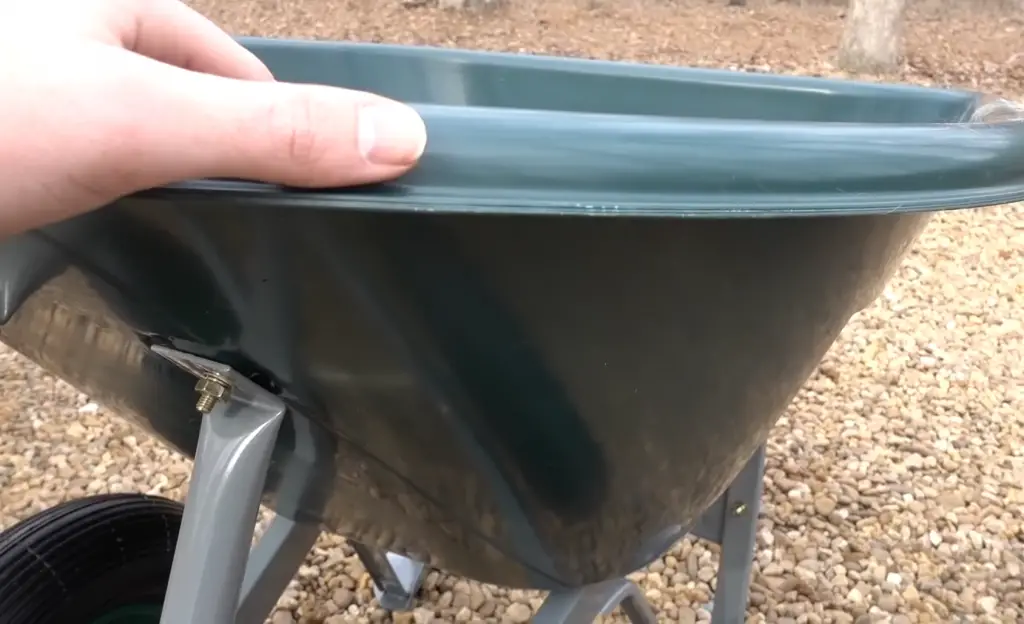
Poly Wheelbarrow Advantages
Polyethylene wheelbarrows are a great choice for many gardeners, thanks to their lightweight design and durability.
Additionally, polyethylene has the advantage of being virtually waterproof so it’s easy to clean and maintain. Another great feature of these wheelbarrows is that some models have flat-free tires which means you don’t have to worry about flats or punctures.
Another benefit of polyethylene is its insulation properties; this makes them ideal for carrying compost, soil, and other materials that need to stay cool in the summer heat. This material also provides a better grip on slick surfaces which is an especially important safety feature when pushing a heavy load. [2]
Poly Wheelbarrow Disadvantages
The main disadvantage of a poly wheelbarrow is its weight capacity. Poly wheelbarrows tend to be lighter than steel but they are limited in how much weight they can carry. If you plan on hauling heavy loads, such as bricks or rocks, then a steel wheelbarrow might be the better option for you.
Poly wheelbarrows also have shorter lifespans than their steel counterparts due to the fact that polyethylene is more prone to cracking and breaking with heavy use. The plastic material can wear down over time from exposure to sunlight and other elements, reducing its durability even further.
Finally, poly wheelbarrows may not have the same stability as steel models when loaded with heavier materials. This can make it difficult to maneuver around large obstacles or uneven terrain. [2]
Using A Steel Wheelbarrow
Steel wheelbarrows have been popular for centuries and their popularity continues to this day. They are strong, durable, and can be made with thicker material than polyethylene models, making them able to hold more weight while still being lightweight enough to maneuver easily. Steel wheelbarrows also come in a range of sizes depending on your needs, from small yard-sized models up to large professional-grade ones.
However, steel is not as corrosion-resistant as some other materials like polyethylene, so if you live in an area with high humidity or salty air it may be damaged over time by rusting or corrosion. Additionally, metal barrows can become hot if left out in the sun for too long. [1]
Steel Wheelbarrow Advantages
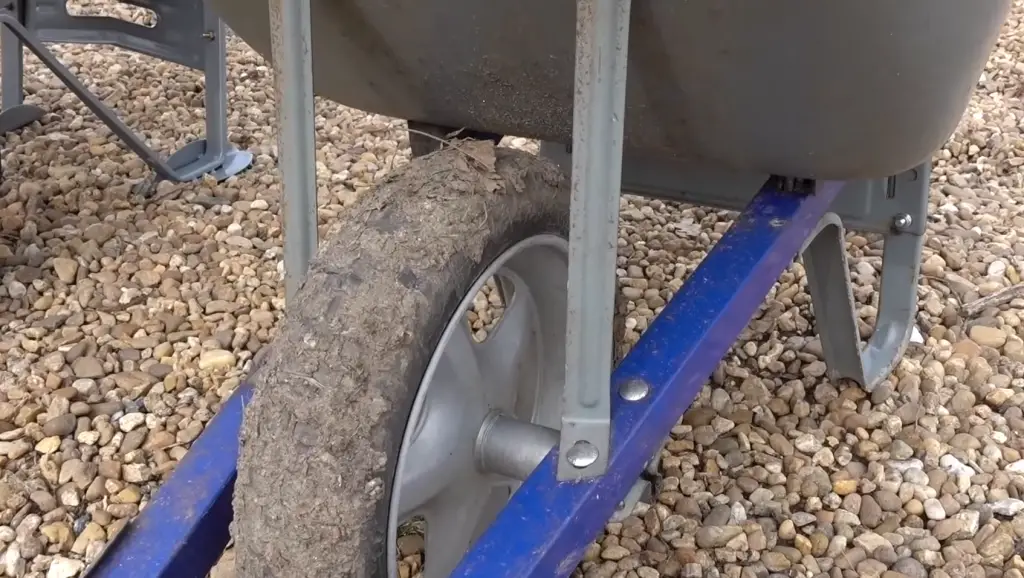
Steel Wheelbarrow Disadvantages
Unfortunately, steel wheelbarrows are not without their drawbacks. They can be heavy and difficult for some to maneuver; they tend to rust over time; and with metal parts, there is always the risk of accidental cuts or scrapes. Additionally, because steel wheelbarrows conduct heat quickly, they can become uncomfortably hot in direct sunlight. [2]
Why Choose Poly Wheelbarrow?
A poly wheelbarrow is a great choice if you’re looking for an ultra-lightweight option. It’s also very durable and resistant to rust and corrosion, making it ideal for tough outdoor jobs. Poly wheelbarrows are easy to maneuver and they typically come with large pneumatic or solid rubber tires that make them easier to push through dirt, mud, and grass. They’re also available in a variety of sizes and shapes, so you can find the perfect fit for your needs.
Another benefit of poly wheelbarrows is the fact that they require very little maintenance. You won’t have to worry about painting it or cleaning it with harsh chemicals like you would a steel model. Instead, just give it a wipe-down with a damp cloth and you’re good to go! Poly wheelbarrows are also relatively inexpensive, making them a great choice for those on a budget. [2]
Why Choose Steel Wheelbarrow?
Steel wheelbarrows are a popular choice for many reasons. Their main benefits are strength, durability, and maneuverability. Steel is also corrosion-resistant, so it won’t rust easily. For those who want to carry heavy loads over rough terrain or need something that can be maneuvered quickly, steel is the way to go.
The strength of steel makes them an ideal choice when carrying large or heavy items such as rocks and soil. You’ll also find they remain steady even when traversing through difficult terrain – making them a great option for landscaping projects or other outdoor tasks that require reliable support. [2]
Environmental Effects
When it comes to environmental factors, the steel wheelbarrow is actually more ideal than a poly wheelbarrow. Steel is infinitely recyclable, meaning that any discarded wheelbarrows can be melted down and reused for new products. Polyethylene, on the other hand, does not break down easily in landfills and can take up to centuries to decompose. Plus, it’s made from non-renewable resources like petroleum, so it’s not as sustainable of an option as steel. So if you’re looking for something eco-friendly, steel is definitely your best bet. [3]
Purpose
When you’re shopping for the perfect wheelbarrow, you may be overwhelmed with so many options. Two of the most common materials—steel and polyethylene—offer unique benefits that can make a big difference in how well your wheelbarrow performs. Knowing which type is best suited to your needs can help you pick the right one for the job. [3]
Handles
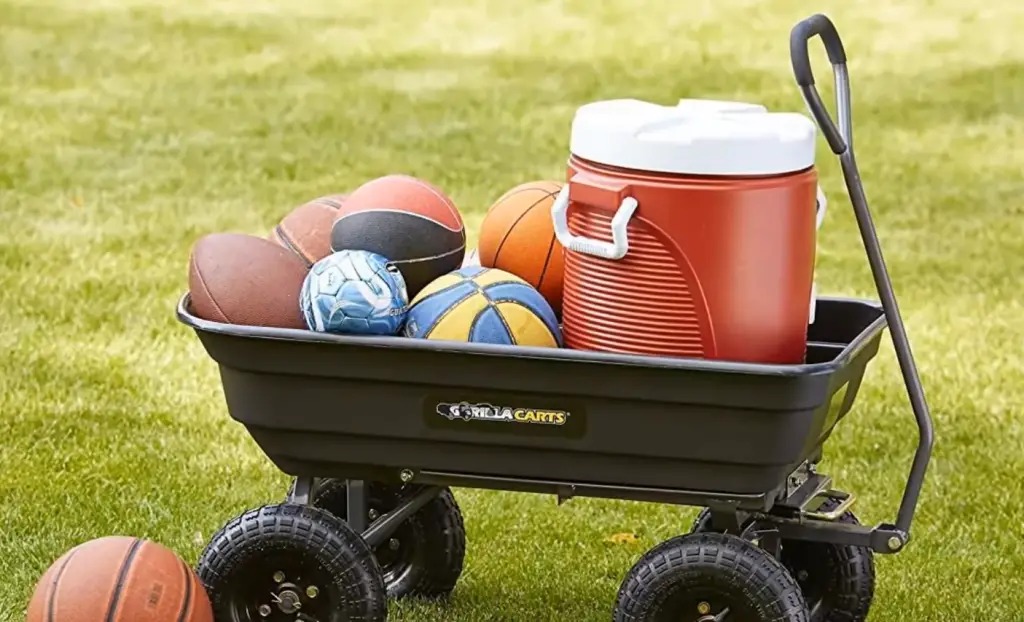
However, if you’re looking for something lightweight and easy to maneuver with one hand, then polyethylene wheelbarrow handles may be ideal. Whichever option you choose will depend on your own preferences and needs when using a wheelbarrow. [4]
Weight
One of the main differences between steel and poly wheelbarrows is weight. Steel wheelbarrows are typically heavier than their poly counterparts, weighing anywhere from 20-50 pounds. Poly wheelbarrows, on the other hand, weigh between 10-15 pounds.
If you’re looking for a lightweight option that can be easily maneuvered around your yard or garden, then a poly wheelbarrow might be the way to go. On the other hand, if you need something more heavy-duty that won’t give out under pressure (like when carrying large rocks or piles of soil), then a steel wheelbarrow could be your best bet. [5]
Cargo Volume
If you plan to move large amounts of material, it’s important to consider the cargo volume of your wheelbarrow. Steel models tend to be heavier, so they can hold more material than their polyethylene counterparts. This makes them ideal for larger jobs like hauling dirt or construction debris. However, if you’re dealing with lighter loads such as gardening materials, a poly wheelbarrow may be a better option. It will provide ample capacity without being too cumbersome or difficult to maneuver. [5]
Grips
When it comes to wheelbarrows, the grips are an important factor in deciding which type is better. Both steel and poly wheelbarrows have handles that can be gripped with ease, but there are key differences between them. Steel handles tend to be thicker and more rigid than those on poly wheelbarrows. While this offers greater durability, it can make for a less comfortable grip, especially if you are using the wheelbarrow for longer periods of time. [5]
Warranty
When it comes to warranty, steel wheelbarrows usually come with a longer warranty than polyethylene ones. Steel wheelbarrows often come with lifetime warranties, while polyethylene wheelbarrows typically have shorter warranties that range from 1-2 years. This is because the metal body of a steel wheelbarrow is more durable and less likely to break down over time than plastic. [5]
Wheels:
One Or Two?
When it comes to wheelbarrows, you can choose between models with one wheel or two. Generally speaking, a wheelbarrow with one wheel is easier to maneuver and will be better suited for navigating tight spaces. However, these single-wheeled models are not as stable as the larger two-wheeled varieties, so they may be tippier when loaded up with heavy materials.
Two-wheeled wheelbarrows are more difficult to turn and require more effort from the user. That being said, they are much sturdier than single-wheel models and can handle heavier loads without tipping over easily. They also create less strain on your back since you don’t have to lift them off the ground as often. [4]
Pneumatic Or Non-Pneumatic?
Wheelbarrows can also be purchased with either pneumatic or non-pneumatic wheels. Pneumatic tires are generally preferable, as they offer a smoother ride and improved traction on rough surfaces. These tires also absorb shock better than their solid counterparts and create less vibration when in use.
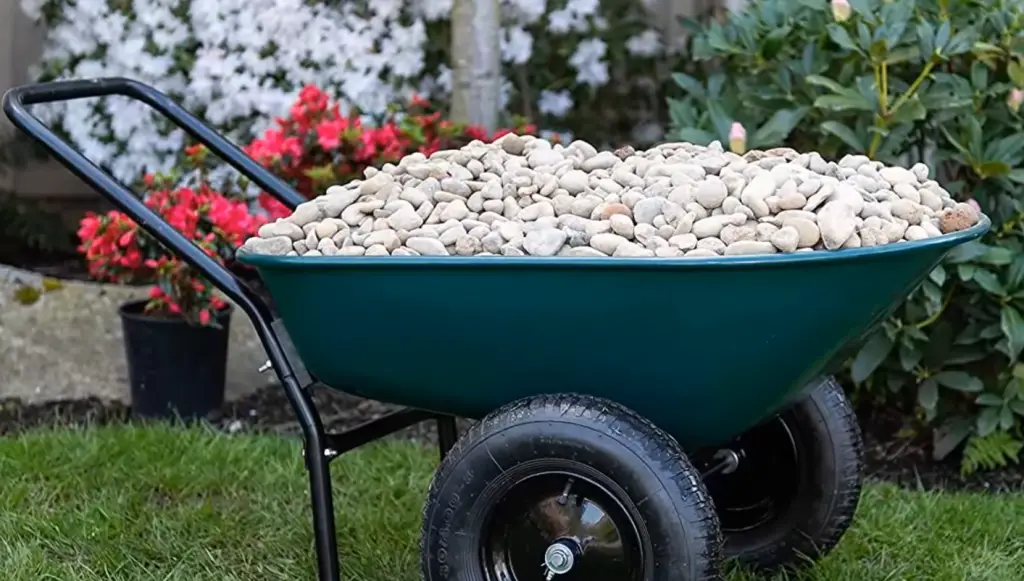
Non-pneumatic tires tend to be cheaper and require less upkeep than pneumatic ones since they don’t need to be filled up with air regularly. However, the lack of cushioning makes them more prone to jarring during use, which can lead to back strain over time. [4]
Which is better to buy?
When comparing steel and poly wheelbarrows, the answer to the question of “which is better?” will depend greatly on your particular needs. A few factors you should consider when making this decision include how often you plan on using it, what types of materials you will be hauling with it, and how much weight it can support.
If you need a wheelbarrow for occasional use- like moving soil or transporting light items around the yard- then a polyethylene wheelbarrow would likely be your best option. They are lightweight, durable, and easy to maneuver through tight spaces. Plus they are generally less expensive than their steel counterparts. [5]
FAQ
What type of wheelbarrow is best for mixing concrete?
When it comes to mixing concrete, steel wheelbarrows are best. The material is sturdy enough to handle the weight of the cement and other materials in your mixture without buckling or warping. Steel is also better for carrying heavier loads than a polyethylene wheelbarrow would be able to manage.
How strong are plastic wheelbarrows?
Plastic wheelbarrows are generally considered to be the lighter and more maneuverable option when it comes to wheelbarrows. They are also typically cheaper than steel models, so they may be a good choice for those on a budget. Despite their lightweight construction, plastic wheelbarrows can carry up to 300 pounds if necessary.
What’s the best builder’s wheelbarrow?
When it comes to builders’ wheelbarrows, the best choice is usually a heavy-duty steel model. Steel wheelbarrows are strong enough to support large loads and won’t bow or warp over time as a plastic model might. They are also more likely to have features such as reinforced handles, stronger wheels, and better construction that will make it easier to move the load around.
How much weight can a poly wheelbarrow hold?
The weight capacity of a poly wheelbarrow will depend on the specific model. Generally, most plastic wheelbarrows can hold up to 300 pounds. However, if you are planning to use the wheelbarrow for heavier loads it is always best to err on the side of caution and go with a steel model instead.
What wheelbarrows do builders use?
Most builders will opt for a heavy-duty steel wheelbarrow because of the strength and durability it offers. Steel wheelbarrows are designed to be able to carry large loads without buckling or warping over time, and they often come with reinforced handles and higher-quality wheels that make them easier to move around.
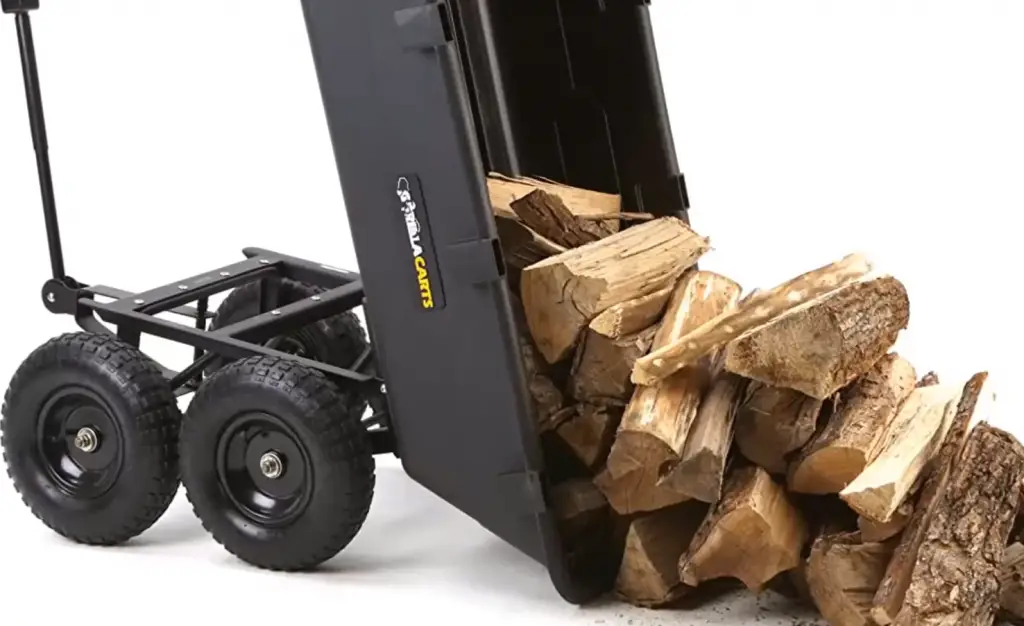
What should I look for in a wheelbarrow?
When choosing a wheelbarrow, look for one that is strong enough to handle your intended use. You also want to make sure it has high-quality construction and reinforced handles. If you are looking for a lightweight option, plastic wheelbarrows can work but they may not be as durable over time. Consider the weight capacity of the model you choose and make sure it can handle the load you intend to use it for. Finally, check the wheels on your wheelbarrow – they should be able to carry the weight of a full load without breaking or coming off.
What are poly wheelbarrows made of?
Poly wheelbarrows are made of a plastic material called polyethylene. This is a strong and durable material that is resistant to corrosion, UV rays, and all types of weather. It is also lightweight, making it easier to move around with less effort than a steel model.
What is a good size for a wheelbarrow?
The size of the wheelbarrow you choose will depend on the type of job you intend to use it for. Generally, most wheelbarrows come in two sizes: small and large. Small wheelbarrows are typically used for carrying lighter loads while larger ones can handle heavier materials such as cement or soil. When choosing a wheelbarrow, make sure you get one that is the right size for your needs.
Useful Video: Best Wheelbarrow for Landscaping? Single, Dual Wheel, Metal, Poly?
Conclusion
At the end of the day, both steel and poly wheelbarrows have their pros and cons. It all comes down to your individual needs and preferences. Steel wheelbarrows can withstand heavy loads and more abuse, but they’re also heavier for transporting them around. Poly wheelbarrows are lightweight and easy to maneuver, but they may not be as durable.
So, ask yourself what you need and want in a wheelbarrow before making your decision. Consider how the barrow will be used, how much weight it needs to carry, and what features are most important to you. With some thought and research, you can find the perfect wheelbarrow for all of your projects. Good luck!
References:
- https://www.backyardboss.net/wheelbarrow-plastic-vs-steel/
- https://www.gfloutdoors.com/wheelbarrow-poly-vs-steel-which-is-best/
- https://www.organizewithsandy.com/plastic-vs-steel-wheelbarrows/
- https://www.bobvila.com/articles/how-to-choose-a-wheelbarrow/
- https://homebounties.com/plastic-vs-steel-wheelbarrows-which-is-better-to-use/










Leave a Reply
View Comments